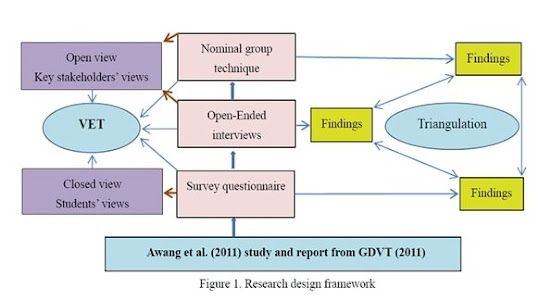Research Triangulation Strategy
Some Problems in Research:
•
Inaccurate Data i.e. Data acceptability
•
Biasness
in Data Collection
•
Interviewer
not match with population
•
Wrong
research methodology i.e. usually use a single research method
•
Research data collection period is not justified
•
Research
result based on false data
Importance:
• Triangulation
offers the prospect of enhanced credibility
• By
combining multiple observers, theories, methods, and empirical materials,
researchers can hope to overcome the weakness or intrinsic biases and the
problems that come from single-method, single-observer, single-theory studies.
• Triangulation,
when used between qualitative and quantitative methods, can also increase the internal validity of your
research.
• Often
the purpose of triangulation in specific contexts is to obtain confirmation of
findings through the convergence of different perspectives.
Basic Concept of Triangulation:
• Triangulation
is an approach to research that uses a combination of more than one research
strategy in a single investigation.
• It
is often used to indicate that more than two methods are used in a study
with a view to double (or triple) checking results. This is called cross-examination.
• It
assumes that data from different methods will collaborate with one another, where
the choice of methods is intended to investigate a single social phenomenon
from a different viewpoint.
Types of Triangulation:
• Denzin
(1970) extended the idea of triangulation beyond its conventional association
with research methods and designs.
•
Types of triangulation:
1. Data Triangulation
(Time,
Space, Person)
Collect data from different times, spaces and peoples.
2. Investigator triangulation
3. Methodological triangulation
4. Theoretical triangulation
Data Triangulation:
•
Time
triangulation:
1. Time triangulation, researchers
collect data about a phenomenon at different points in time.
2. Consider the season, Rainy day or
sunny day etc)
•
Person
Triangulation:
1. Using person triangulation,
researchers collect data from more than one level of person, that is, a set of
individuals, groups, or collectives.
•
Space
triangulation:
1. Space triangulation consists of collecting data at more than one site.
Investigator triangulation:
• Which
refers to the use of more than one researcher in the field to gather and interpret
data.
• Investigator
triangulation occurs when two or more researchers with different backgrounds
and expertise works together on the same study. To achieve investigator triangulation,
multiple investigators each must have prominent roles in the study and their
areas of expertise must be complementary.
• All
the investigators discuss their individual findings and reach a conclusion,
which includes all findings.
Theory triangulation:
Involves using more than one theoretical scheme or perception in the interpretation of the phenomenon.
Methodological
triangulation:
Involves using more than
one method to gather data, such as interviews, observations, questionnaires,
and documents.
Using different approach to the same topic.
What is NGT?
• The Nominal Group Technique (NGT) is a variation of brainstorming where individuals come up with ideas on their own rather than as a group. Once different ideas are established, they are evaluated, ranked, and agreed upon collectively. The top-ranked ideas are selected as the output of this process.
• What is NGT Process?
– The process is a combination of the focus group discussion and voting phase that was developed by Varga-Atkins (2011).
– It has 5 phases namely:
(1) Present key questions to the participant;
(2) Silent phase;
(3) Round Robin phase;
(4) Discussion/item clarification phase, and
(5) Voting phase.
Ref: https://en.m.wikipedia.org/wiki/Triangulation_(social_science
Triangulation Case study
Three Approaches was used here for primary data collection method:
- Quantitative (Questioners to
student)
- Qualitative (Open ended
questioner to student parients)
- Nominal Group Technique (NGT) (VET teachers)
The above figure reveals that how the research framework has been designed.
References:
- Book:
Social Research Methods By W Lowrance Neuman
- Methodological
Triangulation: An Approach to Understanding Data Abir K. Bekhet College of
Nursing, Marquette University Milwaukee, WI Jaclene A. Zauszniewski
Community Health Nursing, Case Western Reserve University, Cleveland, OH
- http://uir.unisa.ac.za/bitstream/handle/10500/7008/sabinettriangulationhttp___content.ajarchive.org_cgi-bin_showfile.pdf
- (PDF) A Mixed Method Approach Enabling the Triangulation Technique: Case Study in Vietnam (researchgate.net)


Comments
Post a Comment